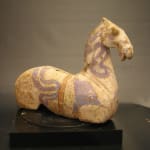A Pair of Han Dynasty White Painted Pottery Seated Horses, 206 BCE - 220 CE
Terracotta
33 x 25.2 cm
13 x 10 in
13 x 10 in
DL.2081
Further images
This fabulous pair of pottery seated horses retain much of their original polychromy. The harnesses are carefully outlined in black and orange hues against their white bodies. The saddles are...
This fabulous pair of pottery seated horses retain much of their original polychromy. The harnesses are carefully outlined in black and orange hues against their white bodies. The saddles are boldly depicted, but the most charming detail is the elaborate purple scrollwork that ripples over the figurines. The mouths of these magnificent creatures are slightly ajar and it is clear from their finery that the represent the prized possessions of a member of the elite of Han society.
Valued for their speed, strength and beauty, horses were one of the most admired animals in China. The horse has enabled man to swiftly transport massive armies into distant and neighboring territories in order to secure vast wealth and land. According to Chinese tradition, there existed a horse so powerful and beautiful that it was believed to be bequeathed from heaven. In early China, owning a horse required wealth and status, eventually becoming a sign of one's social standing. Equestrian activities only encouraged the indulgence of the wealthy few who owned horses. Naturally in Chinese art, the horse became a favorite subject of artists who tried to create visual representations of the animal that captured both its vitality and presence. During the Han Dynasty, the horse was rendered in miniature sculptural form to be interred with the dead. It was believed that the animal could assume its earthly powers and assist the deceased in the dangerous journey to the other world. This custom answered to the needs of a particular belief system regarding life after death and the spiritual world.
Valued for their speed, strength and beauty, horses were one of the most admired animals in China. The horse has enabled man to swiftly transport massive armies into distant and neighboring territories in order to secure vast wealth and land. According to Chinese tradition, there existed a horse so powerful and beautiful that it was believed to be bequeathed from heaven. In early China, owning a horse required wealth and status, eventually becoming a sign of one's social standing. Equestrian activities only encouraged the indulgence of the wealthy few who owned horses. Naturally in Chinese art, the horse became a favorite subject of artists who tried to create visual representations of the animal that captured both its vitality and presence. During the Han Dynasty, the horse was rendered in miniature sculptural form to be interred with the dead. It was believed that the animal could assume its earthly powers and assist the deceased in the dangerous journey to the other world. This custom answered to the needs of a particular belief system regarding life after death and the spiritual world.





